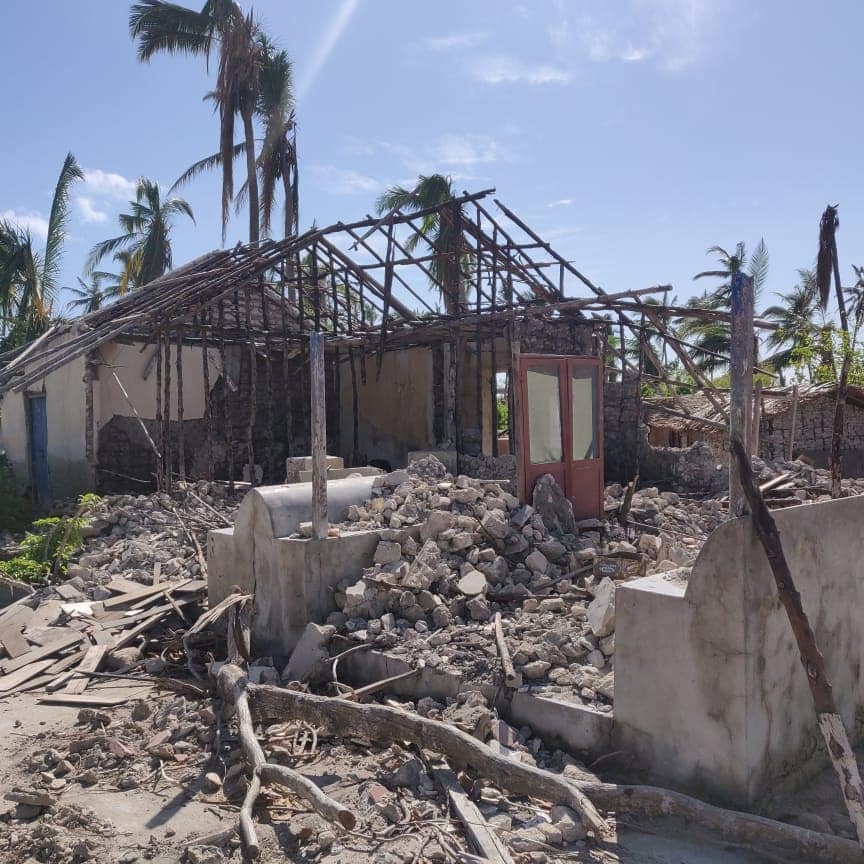Cyclone Kenneth made landfall in northern Mozambique on 25 April 2019, just six weeks after Cyclone Idai hit central Mozambique.
With 200km/h winds impacting Cabo Delgado and Nampula Provinces, Cyclone Kenneth affected over 280,000 people.


Macomia District following Cyclone Kenneth. Photo: Saviano Abru/UN OCHA, April 2019.
In certain districts entire villages were destroyed, and communities left without shelter, food, crops and assets.

Destruction on Matemo Island following Cyclone Kenneth. Photo: IOM Mozambique, 2019
Over 35,000 homes were damaged or destroyed in Cyclone Kenneth and over 20,000 people were displaced.

Destruction on Matemo Island was widespread. Photo: IOM Mozambique, 2019.
The Government of Mozambique through their National Institute for Disaster Management (INGC) requested support from the humanitarian community to provide for urgent needs: shelter materials, non-food items, and food assistance.

IOM staff conduct assessment following Cyclone Kenneth. Photo: IOM Mozambique/2019
Following assessments, IOM began a project funded by European Civil Protection and Humanitarian Aid Operations (ECHO), which responded to the request to provide shelter assistance.

IOM staff conduct follow-up visit with community. Photo: IOM Mozambique, 2019
Field assessments and community discussions revealed needs at each location. Beneficiary lists were compiled by the IOM shelter team together with local authorities and community leaders who identified vulnerable households.

Toolkits funded by ECHO, bagged and prepared for distribution. Photo: IOM Mozambique, 2019.
The project focused on seven districts- heavily affected areas that had not yet received distributions-including villages in Ancuabe, Macomia, Mecufi, Meluco, Metuge, Muidumbe, and Quissangua. Locations were coordinated with Shelter Cluster partners and implementing partners.

ECHO funded toolkits and tarps just before distribution. Photo: IOM Mozambique, 2019
IOM and implementing partners CARITAS and Ayuda en Accion distributed ropes and tarps – one per household - due to widespread needs, in order to reach more communities. Toolkits included a saw, hammer, snipper, rope, wire and nails. In some distributions one toolkit was provided for every four households–also due to the scale of need–with items shared among beneficiaries.

This man's family used the tarpaulin to create a division of spaces within their shelter. Photo: IOM Mozambique 2019
Toolkits were used to rebuild, repair or to gather local materials from the woods. Tarps were used to fix and rebuild houses, as a mat, to isolate rooms, to block wind, and cover beds.

Many families used the tarpaulin to reinforce their roofs. Photo: IOM Mozambique 2019
One community leader stated that the distributions “helped to alleviate people’s suffering”. A father stated “the tarpaulin is keeping my children away from the cold at night.” An elderly woman said “the toolkit is helping my son to rebuild my house."

Follow-up interview conducted with a man who received a tarpaulin and toolkit. Photo: IOM Mozambique, 2019.
The shelter effort reached over 13,000 households (nearly 66,000 individuals). Materials were purchased within Mozambique through suppliers from Maputo, Nampula and Cabo Delgado.
Chief of Changane village Fernando Iassine, spoke about the effect of Cyclone Kenneth on his community.
“In Changane there are 6,250 families. In Cyclone Kenneth around half of the families lost roof panels, and the homes more than 1,000 families were destroyed,” said Iassine. “There were some injuries because of the metal roofing panels that flew off houses during the cyclone, and the nails and other remnants left on the ground.
“The distribution was the first assistance we received in Changane after the cyclone. Each family received a tarpaulin and toolkit- including a hammer, nails, saw, catana (knife) and wire cutters and a hoe. The materials were of good quality.
"When families whose lost their homes received the kits they used the tools to collect wooden poles and bamboo and constructed 'cabanas' (informal homes) to live in. They are using the tarpaulins to cover their houses. The tarpaulins help, but because it is now rainy season water still enters when it rains.
"Some homes are being repaired, but many homes are not yet repaired or rebuilt, and the families continue to live in 'cabanas'.
"Life is worse now than before the cyclone, and more assistance is needed for reconstruction of homes. I only want for people in Changane to be able to rehabilitate their homes.”

Follow-up interview conducted with a woman who received a tarpaulin and toolkit. Photo: IOM Mozambique 2019
“My house fell in Cycle Kenneth. At the time I was at my in-laws’ home; my children and I continue to stay with them, because our home is still in pieces,” said Ilerta, 34 years old.
“These items that I have received will help me, but if it is possible, I still need additional materials to construct my house. I am very scared with this rainy season; I don’t know what will happen.”
Humanitarian aid following Cyclone Kenneth has reached tens of thousands of individuals, but due to the widespread effects of the storm, additional assistance is still needed for affected communities to fully recover.